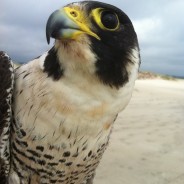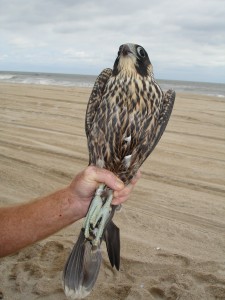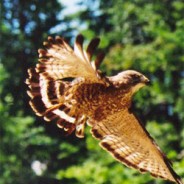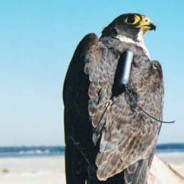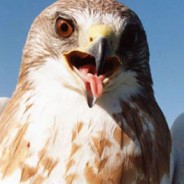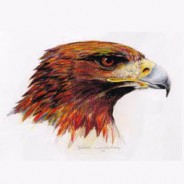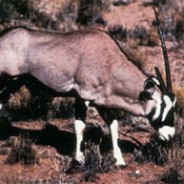Earthspan biologists conduct many important projects in addition to their landmark peregrine falcon research.
54 Years of Peregrine Falcon Studies
Earthspan principals conduct long-term studies on migrating tundra Peregrine Falcons (Falco peregrinus tundrius) at Assateague Island, MD/VA (autumn since 1970) and Padre Island, TX (autumn and spring since autumn 1977). In 2019 we entered into a partnership with The Peregrine Fund to continue these studies. We have expended 59,010 man-hours of survey time in observing 75,304 peregrines and capturing 16,851. The tundra peregrine made a significant recovery and has been removed from the list of endangered species yet continued monitoring of populations is imperative. Because of the continuity and standard method for data collection these surveys have become an essential tool in that effort. Our database at Assateague includes sightings of every other raptor we have observed on the Island since 1970. Some 90% of all observations there have been recorded by three experienced individuals who have also conducted springtime studies at Padre Island. At Padre a more diverse cast of highly qualified individuals has participated.
Our work in these studies with satellite-received telemetry allows us to continue elucidating previously undescribed aspects of the tundra peregrine’s wintering biology and continental migration and to identify critical habitats. Given available technologies, Assateague and Padre remain ideal laboratories in which to study and address present and future issues of concern to peregrines, other Neotropical migrants, and humans. We increment and maintain an archive comprising thousands of peregrine blood samples that we have used to study genetics, demographics, contaminants and emerging pathogens. In recent years we have studied infectious pathogens such as West Nile Virus and Avian Influenza in partnership with U.S. Government entities and addressed contaminants through studies related to the 2010 Gulf oil spill.
Blood and feather samples collected from peregrines contribute to collaborative mercury monitoring efforts. We began an effort with Utah State University in 2022 to document Avian Influenza exposure in migrant peregrine falcons through the seroprevalence of associated antibodies and indicate if some individuals survive infection. We tested 442 samples and 6 birds had antibodies. For spring and fall 2021 which is the period before the AI outbreak started, the combined number of positives is 1 out of 179 birds (0.56%, which is similar to past studies). For Spring 2022, Fall 2022, and Spring 2023, the outbreak period, the combined number of positive birds is 4/205 (1.95%). The number of birds with antibodies remains very low, but higher than reported in past surveys. The percentage of peregrines with antibodies in past studies in the US was 1/472 (0.2%) in 2006 to 2010, and 2/299 (0.67%) in 2001 to 2004. The only encouraging news is that AI exposure is not invariably fatal to peregrines, although most succumb rapidly.
In 2008 our database allowed us to provide an Expert Declaration on the Draft Environmental Assessment and Management Plan for Take of Migrant Peregrine Falcons in the United States for Use in Falconry. Among other points, we concluded that the standardized average number of migrating peregrines we observed at Assateague over the preceding 29 years was essentially the same as that seen more than six decades ago (1939-1944), before DDT had serious adverse effects on the reproductive potential of the peregrine in North America. Our work at Assateague and Padre Islands represents the bulk of tundra Peregrine Falcons banded within the continental United States since the establishment of the Bird Banding Laboratory by the Department of the Interior. Furthermore, our overall database constitutes the most significant and longest continuous monitoring study on this falcon in the Americas. Long-term studies such as ours are essential to monitoring the stability of wildlife populations, particularly in light of rapid changes that may occur due to contaminants, infectious diseases, habitat loss, climate change and other factors. By the long-term and standardized nature of our studies, we have established levels of observation in stable populations that will quickly raise future concerns if not achieved over a several year period.
Assateague Survey 2024 – Between 25 September and 18 October, the survey team of Mike Yates and Bill Seegar expended 233 man-hours in the field, recording 106 sightings of peregrines and capturing 27 different individuals. Three of the falcons captured were previously banded, all marked as nestlings from the eastern population established through captive breeding and release. The 106 sightings included 34 observations of individuals previously captured during the survey. By unit effort (per 10 man-hours), sightings were the 7th lowest and captures the 3rd lowest among our 54 survey years, a disappointing continuance of our recent downturn in numbers.
A major concern has been that populations are adversely affected by the Highly Pathogenic Avian Influenza (HPAI) outbreak of 2021-24. A long-term survey on Alaska’s Yukon River has also shown a concurrent decrease. Since 1973 Skip Ambrose has surveyed 165 miles of the upper Yukon and documented a recovery from 12 to over 60 pairs of peregrines by 2012. In 2023-2024 adults were noticeably missing; in 2024 a third of eyries were unoccupied and multiple others had only single birds. Among 75 territories Ambrose monitored in 2012-2019 an average of 77% were occupied by a pair. By 2024 that percentage had dropped to only 43%.
We know that HPAI is almost invariably fatal to peregrines that become exposed. They are not colonial birds and thus contract HPAI only through infected prey. We also know that waterfowl and shorebirds are highly susceptible to HPAI and that peregrines single out compromised individuals. There is also a disparity in prey selection by adult peregrines versus juveniles, with higher percentages of shorebirds taken by the former and passerines by the latter. These facts provide context to recent reports from other sources. There was high turnover among adults in VA in 2024, highest at coastal eyries where peregrines rely more upon shorebirds as prey. Nest site fidelity is very high among peregrines, and those missing adults are dead. Two coastal eyries became unoccupied and second-year females were at two sites, suggesting the normal supply of non-breeding adult “floaters” that usually replace missing breeders is depressed. Two dead adults recovered in VA tested positive for HPAI, and the USDA reported 50 such confirmed cases of peregrine deaths nationwide since 2023. High adult replacement rates were also reported in NJ. There were either at least one new breeder or no breeders at all at 50% of their 44 nest sites in 2024, and 63% at coastal sites. The normal adult replacement rate in NJ is 15%, and a second-year pair attempted to nest at one site.
In response to the alarm raised by Ambrose and others (including our reduced numbers at Assateague and Padre Islands), an internet group was established to encourage peregrine researchers worldwide in redoubling efforts to monitor peregrine breeding and survey metrics and exchange results. In 2024 the normal 16-18 pairs in WA’s San Juan Islands were reduced to five active eyries, and only two of those produced young. Peregrines feed heavily on waterfowl in the Puget Sound area, and postmortems on seven recovered falcons confirmed HPAI as the cause. Other findings from the internet group were that MT recorded a 48% reduction in 2023 occupied sites, 40 pairs in NM had dropped to 28 from 2016 to 2023, and NV had seen a 43% decline among 28 monitored territories.
At Assateague juveniles sighted per 10 man-hours were 3.78, our 10th lowest number ever and well below our 54-year average of 7.15. Adults sighted per 10 man-hours were only 0.38, and only our first three of 53 full surveys recorded a lower number. Our 54-year average is 1.25 adults sighted per 10 man/hours. While 2024 was a very poor showing of adults at Assateague, the age demographic of those adults is an added concern. All four adults captured were in their second year, and one of those was a VA native and not a tundra peregrine. This means only five observed (but not captured) falcons could have been full adult tundra peregrines. As we have previously outlined concerns that adults are more at risk of HPAI mortality due to preferred prey, it would have been more reassuring to have a confirmed full adult or two represented in our sample.
The Survey’s peregrine numbers at Assateague are reduced over the past several years, but it is difficult to assess how much of the reduction is attributable to HPAI-related reductions in population. The island itself has become less hospitable to most migrating raptors, as evidenced by our own observations. Anthropogenic degradation of the island as a prime migration stopover through management and increased public use are among the complicating factors. 2024 Asstg Rept
Padre Surveys 2024 – During the spring migration period Yates, Seegar and Doney surveyed the South Padre Island Unit of Laguna Atascosa National Wildlife Refuge from 11 April through 03 May, conducting 262 survey hours in the field over 23 survey days. Surveys recorded 204 peregrine falcon observations and 21 captures, including 3 seasonal recaptures. Among new captures, 13 (72 %) peregrines were first banded this spring and 5 (28 %) were previously banded. Four of those were Padre Returns marked during the 2022-2023 Surveys, and one a second-year falcon banded as a 2023 nestling in Ashland, Wisconsin. Blood and feather samples were collected from individuals, supporting collaborative studies of peregrine health, genetics and migratory origins. Adults comprised 33% of new captures. The minimum average area stopover duration among seasonal recaptures was 10.3 days, ranging from 1 to 17 days. Our seasonal sighting rate of 7.79 peregrine observations per 10 survey hours is well below the spring 45-year mean of 16.21 (± 6.23 SD).
During the fall migration Gregg Doney’s team surveyed South Padre Island from 24 September through 26 October, conducting 394 survey hours in the field over 33 days. Surveys recorded 457 peregrine falcon observations and 117 captures, including 69 color-marked resights and 16 seasonal recaptures. Among new captures, 99 (98%) peregrines were first banded and 2 (2%) were previously banded Padre Returns marked during the 2022-2023 Surveys. Blood and feather samples were collected from individuals, supporting collaborative studies of peregrine health, genetics and migratory origins. Adults comprised 9% of new captures. The minimum average area stopover duration among seasonal recaptures was 4 days, ranging from 1 to 13 days. Our seasonal sighting rate of 9.85 peregrine observations per 10 survey hours is within, but close to the lower bounds of, the 47-year mean of 15.71 (± 5.56 SD).
Survey counts and capture rates continued to decline in 2024 from a 2016 peak and even more sharply in spring, possibly with related age structure variation among migrants. Similar patterns are emerging at Assateague Island. Among recent 3-year comparisons to total means, spring observations and captures have declined 36% and 61% respectively, and fall rates 34% and 31%. In 2024 spring observation rates dropped 51% and fall rates 37%.
In relation to age structure, the percent of adult falcons captured during spring and fall seasons has declined uniformly by about 50% to present. Declines were gradual among fall seasons at Padre since 2018, but the adult composition of migrants declined abruptly during the 2024 spring season. In addition, an annual age index of the few Padre Returns (known age recaptures) has also steadily declined since 2018. Altogether these patterns of declining populations with age structure variation heighten the concerns for northern migratory peregrine populations that concentrate at Padre Island during migration. 2024 Padre Report
Highly Pathogenic Avian Influenza Studies
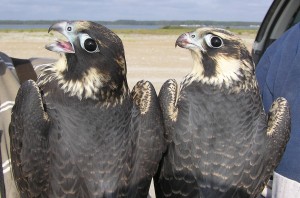 We began a collaboration in December 2022 with Arnaud Van Wettere (DVM, MS, PhD, DACVP)
We began a collaboration in December 2022 with Arnaud Van Wettere (DVM, MS, PhD, DACVP)
at the School of Veterinary Medicine, Utah State University. Entitled Prevalence of Avian Influenza A Virus Antibodies in Migrating North American Peregrine Falcons, it is summarized thus:
An outbreak of highly pathogenic avian influenza (HPAI) virus H5N1 started in the fall of 2021. The scale of this outbreak is unprecedented; it is the largest and most prolonged to date in the USA. Raptors are known to be particularly susceptible to HPAI, with most succumbing within a few days post infection. Given that Peregrine Falcons often prey on bird species known to carry the virus asymptomatically (e.g., waterfowl, gulls, shorebirds), they are at a higher risk of exposure to the virus than most raptor species. While a small number of wild Peregrine Falcons and falconry birds that succumbed to HPAI virus infection have been found during this outbreak, data on how many falcons survive infection is lacking. Studies during past outbreaks have shown that very few falcons (<0.1%) have antibodies to avian influenza virus. However, past HPAI outbreaks occurred in the fall and/or winter and disappeared in early summer with the return of warm temperatures. Therefore, exposure to the virus of Peregrine Falcons that migrate to Central and South America for the winter was likely limited. As this outbreak started in the fall of 2021 but persisted during the summer and fall 2022, Peregrine Falcons are more likely to have been exposed to HPAI virus than in past outbreaks. The goal of this study is to detect evidence of exposure to avian influenza virus. The presence of antibodies to avian influenza virus will be evaluated in the plasma of Peregrine Falcons captured during the fall and spring of 2021-2022 and the spring of 2023 to determine how many Peregrine Falcons have developed an immune response against the virus. Determining the prevalence of antibodies against avian influenza virus will provide documentation of exposure to the virus in migrant Peregrine Falcons and indicate whether some falcons survived infection.
We have tested 571 peregrine samples, with 6 birds positive for influenza A antibodies. For spring and fall 2021 (the period before the HPAI outbreak began) the combined number of positives is one out of 236 birds (0.42%, similar to past studies). For the outbreak period of Spring 2022 (0/26), Fall 2022 (4/107, 0/45), Spring 2023 (1/25), Fall 2023 (0/96, 0/36) the combined number of positive birds is 4/335 (1.19%). A single individual sampled during different migrations accounted for two of the positives, so was removed from the 2022-23 results. This is of keen interest in relation to immunity persistence among peregrines. The number of birds with antibodies remains very low, but perhaps higher than reported in past Surveys. The percentage of peregrines with antibodies in past studies in the US was 1/472 (0.2%) in 2006 to 2010, and 2/299 (0.67%) in 2001 to 2004, and 2 of 109 falcons (1.83%) during the large outbreak of 2014 to 2015. The encouraging news is that AI exposure is not invariably fatal to peregrines, although most succumb rapidly. We also infer that serology metrics in peregrines do relate to the scale of outbreaks, which has grown considerably. We look forward to the 2024 serology information gathered and screening results.
Analysis of Mercury in Migrating Peregrines Published
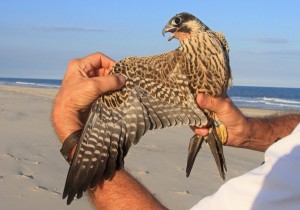 With collaborators Joe Barnes of the Nevada Department of Wildlife and Shawn Gerstenberger of The University of Nevada at Las Vegas we have published our most recent assessment of mercury in feathers we collected 2009-2015 from migrating peregrines at Assateague (MD) and South Padre (TX) Islands. We detected mercury in all sampled fourth primary (range = 0.44–37.46 lg/g) and axillary feathers (range = 0.09–62.68 lg/g). The concentration associated with toxic effects in peregrines is unknown; however, peregrines have recently experienced broad population expansion across the presumed breeding area (northern latitudes of North America) of the birds we sampled. The mercury concentrations we measured were lower than those in an apparently healthy breeding population in the southwestern USA. The literature citation follows, and a PDF is available in Publications, under the About Us tab.
With collaborators Joe Barnes of the Nevada Department of Wildlife and Shawn Gerstenberger of The University of Nevada at Las Vegas we have published our most recent assessment of mercury in feathers we collected 2009-2015 from migrating peregrines at Assateague (MD) and South Padre (TX) Islands. We detected mercury in all sampled fourth primary (range = 0.44–37.46 lg/g) and axillary feathers (range = 0.09–62.68 lg/g). The concentration associated with toxic effects in peregrines is unknown; however, peregrines have recently experienced broad population expansion across the presumed breeding area (northern latitudes of North America) of the birds we sampled. The mercury concentrations we measured were lower than those in an apparently healthy breeding population in the southwestern USA. The literature citation follows, and a PDF is available in Publications, under the About Us tab.
Barnes, J.G., G.E. Doney, M.A. Yates, W.S. Seegar, and S.L. Gerstenberger. 2019. A Broadscale Assessment of Mercury Contamination in Peregrine Falcons Across the Northern Latitudes of North America. J. Raptor Res. 53(1):1-13.
Polycyclic Aromatic Hydrocarbon Monitoring in Migratory Peregrines
The Deepwater Horizon Oil Spill (DWH) released an estimated 5 million barrels of oil into the Gulf of Mexico during April through July 2010. Earthspan and its partners, The Peregrine Fund and the University of Connecticut, collected and analyzed blood samples from migrating Peregrine Falcons (more…)
Wintering area DDE source to migratory white-faced ibis revealed by satellite telemetry and prey sampling
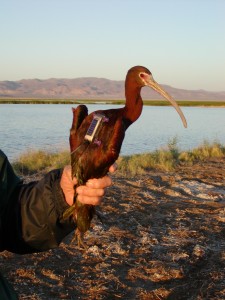
White-faced ibis with PTT package
Earthspan principals led a cooperative study to identify the source(s) of DDT-related contamination still plaguing a northern Nevada population of white-faced ibis many years after use of the pesticide was banned in the United States. (more…)
Broad-winged hawk: Movements and habitat association during migration and wintering periods
Problem/Background
Modern organophosphate insecticides are short-lived in the environment. These insecticides are toxic to raptors, but they are unlikely to be detected in animal blood or tissue unless the animals are sampled soon after exposure. Researchers postulate that pesticide exposures, and habitat alteration, in their wintering (more…)
Summary of Final Report: Study of Peregrine Falcons Wintering on the Gulf Coast of Mexico
Abstract
Fundación Ara and Earthspan conducted a study of peregrine falcons (Falco peregrinus) wintering on the Gulf coast of Mexico. Data collection occurred between January 1997 and October 1998. The main aim of the study was to better understand the movements of peregrine falcons on their wintering grounds. Other objectives were to track peregrines to their breeding areas (more…)
Swainson’s Hawk: Scientific Research Rescues Species Before Threatened or Endangered Status Listing is Needed
Problem/Background
The Swainson’s Hawk (Buteo swainsonii, SWHA) is listed as a species of concern by five states and the Bureau of Land Management, and as a special emphasis species by the U.S. Forest Service. Nesting population declines was reported over much of the SWHA range in the early 1990s. With no obvious reason for this decline, (more…)
A Study of The Golden Eagle in Mexico
Selected Passages from the Final Report to Proyecto ARA A.C.
Introduction
Mexico’s national bird, the golden eagle (Aquila chrysaetos), is classified as “in danger” in Article 9 of the Federal Hunting Law (SEDUE 1984) and Ramos (1986) classifies the population as declining, primarily due to decreases in habitat quality. Environmental pollution (more…)
Satellite Tracking Oryx
Accomplishments
White Sands Missile Range, New Mexico
White Sands Missile Range (WSMR) is the military’s largest all-overland test range in the Western Hemisphere and encompasses 2.2 million acres, which can be extended to 4 million acres (total) by including adjacent federal land holdings. WSMR houses the U.S. Army Research, Development, Test, and Evaluation (more…)

